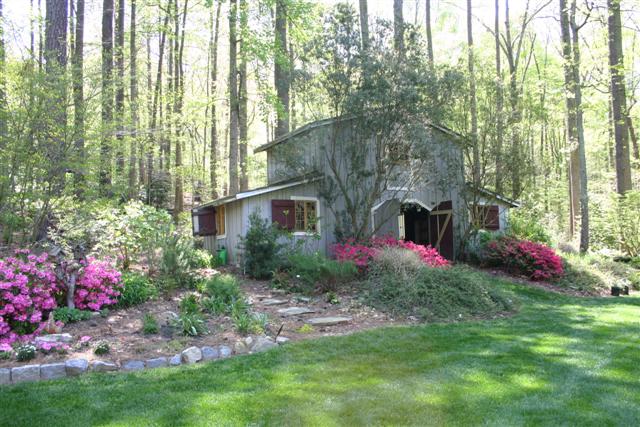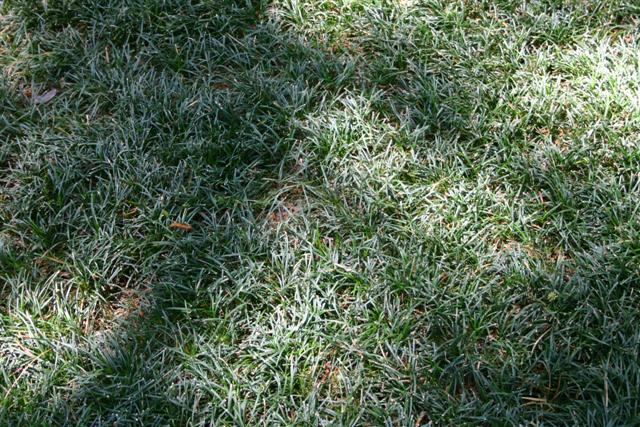Georgia Gardener Newsletter Design Tip: March 5, 2009
Growing Grass in "Shade"

|
Need help?
Check out our Services.
We're also offering a 10% discount
for March appointments
|
|
Fescue at the edge of a woodland
|
It never fails that on a weekly basis, we get at least one (usually more) questions about how to grow grass in the shade.
The question usually originates from men, which leaves me to determine this is a guy thing.
The difficult part about answering this lies with how you define two key words in the question: grow and shade.
Yes, newly planted grass will grow in shade for a while but it usually ends up declining and being a disappointment.
No doubt, I will get numerous emails saying that this person or that has grass growing just fine in the shade, but..
how do you define shade. Just how much and when you have an area in the shade will determine what, if any, type
of lawn you can have.
Defining Shade
It seems there are more terms to define shade than there are types of turf grasses. I've seen shade described as partial,
moderate, light, heavy (or full), morning, afternoon, bright, dappled and the list goes on. I'm going to break it down
by hours of sunlight and the time of day. The hours of sunlight should be calculated during the growing season when the sun
is highest in the sky and the trees have a full canopy of leaves. What's in full sun in January may be in full shade
by July.
Full sun or no shade: the ground receives 6-8+ hours of continuous direct sunlight. This is the area you don't want to be
standing on an August afternoon. It's also the easiest area to grow the warm season turf grasses: bermuda, zoysia, centipede and
st. augustine. Fescue will struggle here if the soil is not well amended and the drought is in full swing.
Morning sun - afternoon shade: this is pretty self-explanatory. The area is in the sun usually from early to mid morning up until
noon. It receives about 4 hours of direct morning sunlight but after that is in the shade. Keeping in mind that morning sun
is less intense than afternoon sun, probably restricts this area to growing fescue. Warm season grasses like bermuda, centipede,
st. augustine and zoysia won't do well in this location especially if other stress factors like heavy traffic and drought
come into play.
Afternoon sun - morning shade: this is the opposite of above. This area usually receives direct sunlight for 4-6 hours sometime
after the noon hour. Note that it still has less hours of sunlight than full sun. If the amount of afternoon sun is closer to
4 hours, you can probably still grow fescue but may be able to add st. augustine and some of the more shade tolerant zoysia
varieties. If you are closer to 6 hours (but still not at 8), fescue may struggle but st. augustine, zoysia and centipede will
probably be okay. Bermuda probably won't thrive here. Keep in mind these grasses may not tolerate as much traffic.
Light shade: the area receives about 4-6 hours of sun at some point during the day. The total sunlight hours may not be
continuous and broken into early morning, midday and late afternoon.
Fescue is probably your best choice in this location especially if you can let it get
a bit taller (3-4 inches). You can try st. augustine or more shade-tolerant varieties of zoysia but be prepared for
failure especially if you have only about 4 hours of sunlight.
Partial shade: the area receives about 3-4 hours of sunlight during the day. At this point, you are down to fescue as your only
option and it will be a gamble at best. Fescue usually planted in this type of situation (especially if the soil isn't well
prepared) often looks great from October to April, thins out and looks terrible by July, is dead and having to be reseeded in
September. Getting a fescue lawn to grow here may require thinning limbs of nearby trees to allow more sunlight, having a well
prepared soil, letting the fescue grow a bit taller, having proper fertilizer use, reducing herbicide use and minimizing traffic.
Moderate to heavy shade: the area receives less than 3 hours of sunlight during the day. Forget about growing any perennial
lawn. Like partial shade, you may have brief seasonal success with fescue but this area is best converted to beds of
shade-tolerant plants,
a moss lawn
or "sodded" with dwarf mondo grass as a lawn alternative (see image at bottom).
Put Another Way
The shade tolerance of the most widely planted turf grasses from least to best are: bermuda, centipede, more shade tolerant
varieties of zoysia, st. augustine and finally fescue as the most shade tolerant.
To those I lovingly call turfheads: you need to know when you've been beaten. If you've had several seasons of failures even
after prepping the soil, changing
grass varieties, mowing higher, etc. it's time to give up having a lawn in this area and to move on to another landscaping
choice.
Finally, on a personal note - nothing irritates me more than having someone contact us saying they are going to or have
already removed their trees simply to get a lawn to grow. These messages are instantly dumped.

|
|
A dwarf mondo lawn
|
Copyright © 2009 by Theresa Schrum - All rights reserved
No part of this website may be reproduced without the expressed written permission of Theresa Schrum


